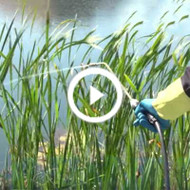Cattail and Emergent Weed Control

Cattails and other emergent aquatic plants can add natural beauty to any pond or shoreline, but if left unchecked for too long, they can overtake these areas and create a maintenance nightmare. A consistent program is the most efficient way to combat the excessive spread of unwanted weeds. Fortunately, there is a simple solution to keeping cattails in check. Follow these tips to maintain a pristine shoreline all season long.
Set Boundaries
Cattails are not all bad. They are nature's solution to providing habitat for wildlife and preventing soil erosion, and they make a great visual barrier to add some privacy to your pond. Like most things, however, cattails are best in moderation. Highlight boundaries where you would like to contain cattails using landmarks, rocks, or other unobtrusive markers. Treat cattails that try to stray from these boundaries to keep their growth under control.
Spray Unwanted Growth
To maximize the effectiveness of your cattail treatments, wait until there is at least 12" - 18" of exposed growth to apply the product. A systemic herbicide like Shoreline Defense Emergent Weed Control & Treatment Booster Plus will kill the cattails down to the root to prevent the plant from re-growing. The roots of cattails are the most challenging part of the plant to kill. So, allow the mixture to absorb into the plant for one to two weeks. This will ensure the treatment gets into the root system. Do not try and stretch the application further than the instructions state. This will likely lead to unsatisfactory results and end up in more products used in the long run.
Remove Dead Cattails
Wait until treated cattails are brown and wilted to remove them from your pond. Cutting them down too early will prevent your chemical treatment from fully reaching and killing the cattail rhizome (root), resulting in a quick return of the weed. Don't leave dead cattails, or any other vegetation, in your pond to decompose. This decomposition turns into nutrient-rich pond muck that fuels new weed growth. Tools exist to make the process as quick and straightforward as possible.
Retreat As Needed
Since cattails have a robust root base, multiple treatments may be necessary to gain control properly. Once under control, they will make a nice addition to your landscape and encourage wildlife to call your pond home.

